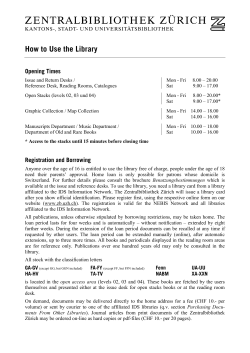
Missed opportunities for reducing the acrylamide exposure
Missed opportunities for reducing the acrylamide exposure of consumers gregor.mccombie@klzh.ch Gregor McCombie, Kantonales Labor Zürich, Meeting on the outcome of the public consultation on “Acrylamide in Food”, 10.12.2014, Brussels Kantonales Labor Zürich Food safety enforcement authority Gregor McCombie, Kantonales Labor Zürich, Meeting on the outcome of the public consultation on “Acrylamide in Food”, 10.12.2014, Brussels Replace Recommendations • EFSA concludes dietary AA is of concern • In 12 years next to no improvement for consumers • More detailed investigations should not be a priority • The main recommendation should be the evaluation of options for mitigation and their effects on consumer exposure Gregor McCombie, Kantonales Labor Zürich, Meeting on the outcome of the public consultation on “Acrylamide in Food”, 10.12.2014, Brussels Rösti Source: http://www.klzh.ch, Lebensmittel, Merkblätter, Acrylamid: Hintergründe und Tipps Gregor McCombie, Kantonales Labor Zürich, Meeting on the outcome of the public consultation on “Acrylamide in Food”, 10.12.2014, Brussels Exposure assessment is biased • Home cooking underestimated • A single portion (250 g) of Rösti can contain 500 – 1250 µg AA; every third day for an adult (60 kg) results in 2.8 – 6.7 µg/kg b.w./day from Rösti alone • The 95th percentile for adults derived in the opinion is at most 2 µg/kg b.w./day Gregor McCombie, Kantonales Labor Zürich, Meeting on the outcome of the public consultation on “Acrylamide in Food”, 10.12.2014, Brussels Mitigation: Potatoes • Regulation of reducing sugars in potatoes for certain uses i.e. chips (french fries) and rösti (fried potatoe products) Rösti – chips <100 µg/kg AA are feasible – Mean (Chips) in opinion 308 µg/kg AA – 140 µg/kg 1100 µg/kg Agria 2000 Acrylamid (µg/kg) • Reducing sugars correlate with AA content • Storage at 9°C prevents high sugar contents • Choice of potato can have a real impact on AA exposure 2500 1500 Urgenta 1000 Fontane Desiree Bintje 500 Charlotte Markies 0 0 1 2 3 4 Fructose + Glucose (g/kg Frischgewicht) Gregor McCombie, Kantonales Labor Zürich, Meeting on the outcome of the public consultation on “Acrylamide in Food”, 10.12.2014, Brussels 5 Mitigation: Ammonium and fryers • Ammonium catalyses AA formation – AA reduction by • Avoiding ammonium (bi)carbonate • Use of asparaginase • AA is formed at the end of frying – Decreasing temperature during frying reduces AA Gregor McCombie, Kantonales Labor Zürich, Meeting on the outcome of the public consultation on “Acrylamide in Food”, 10.12.2014, Brussels Summary • Main recommendation should focus on how effective mitigation can be achieved • More accurate exposure assessment is unnecessary • Suggestions for mitigation measures – Control of reducing sugars in potatoes – Asparaginase for ammonium carbonate dependant food – Improved Fryers Acknowledgements • • • • Koni Grob Maurus Biedermann Christoph Bürgi Kantonales Labor Zürich Gregor McCombie, Kantonales Labor Zürich, Meeting on the outcome of the public consultation on “Acrylamide in Food”, 10.12.2014, Brussels Further reading • Influence of the frying temperature on acrylamide formation in French fries. K. Fiselier, D. Bazzocco, F. Gama-Baumgartner, K. Grob. Eur. Food Res. Technol. 222 (2006) 414-419. • Options for legal measures to reduce acrylamide contents in the most relevant foods. K. Grob. Food Additives and Contaminants 24 (2007) 71-81. • How much reducing sugar may potatoes contain to avoid excessive acrylamide formation during roasting and baking? S. Biedermann-Brem, A. Noti, K. Grob, D. Imhof, D. Bazzocco and A. Pfefferle. Eur. Food Res. Technol. 217 (2003) 369-373. • Potential of acrylamide formation, sugars and free asparagine in potatoes: a comparison of cultivars and farming systems. T. M. Amrein, S. Bachmann, A. Noti, M. Biedermann, M. Ferraz Barbosa, S. Biedermann-Brem, K. Grob, A. Keiser, P. Realini, F. Escher and R. Amadò. Journal of Agricultural and Food Chemistry 51 (2003) 5556-5560. • Acrylamide monitoring 2007-2009 in Switzerland: results and conclusions. M. Biedermann, F. Grundböck, K. Fiselier, S. Biedermann, Ch. Bürgi, and K. Grob. Food Additives Contaminants 27 (2010) 1352-1362. • French fries with less than 100 µg/kg acrylamide. A collaboration between cooks and analysts. K. Grob, M. Biedermann, S. Biedermann-Brem, A. Noti, D. Imhof, Th. Amrein, A. Pfefferle, D. Bazzocco. Eur. Food Res. Technol. 217 (2003) 185-194. • Model studies on acrylamide formation in potato, wheat flour and corn starch. M. Biedermann and K. Grob. Mitteilungen aus Lebensmitteluntersuchung und Hygiene 94 (2003) 406-422. Gregor McCombie, Kantonales Labor Zürich, Meeting on the outcome of the public consultation on “Acrylamide in Food”, 10.12.2014, Brussels
© Copyright 2025










